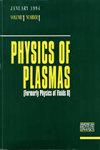Theory of phase-space hydrodynamics of electron and ion holes in collisionless plasmas
IF 2.2
3区 物理与天体物理
Q3 PHYSICS, FLUIDS & PLASMAS
引用次数: 0
Abstract
Phase-space holes are well-known Bernstein–Greene–Kruskal (B.G.K.) modes and are formed by particle-trapping in solitary potential waveforms. They exhibit orbital particle trajectories in the phase-space, due to which they are also referred to as phase-space vortices. In this article, we develop the theory of phase-space hydrodynamics for electron and ion phase-space in collisionless plasmas. The analogy between ordinary two-dimensional fluids and 1D−1V phase-space has been explored by introducing a momentum equation and a phase-space vorticity field, which enable the fluid-like analyses of the plasma phase-space. The developed kinetic-hydrodynamic equations are then employed to address the vortical nature of phase-space holes by exploring their fluid-analogous vortex-like characteristics, an identification technique of phase-space vortices, an exact derivation of the Schamel-df equations, and a measurable definition of the particle-trapping β parameter. This article introduces a new technique to the study of phase-space holes which focuses on the fluid-analogous vortical nature of the phase-space holes and prevents the need for an initial assumption of the trapped and free particle phase-space densities, thus presenting itself as a precursor to the Schamel-pseudopotential method.无碰撞等离子体中电子和离子空穴的相空间流体力学理论
相空间空洞是著名的伯恩斯坦-格林-克鲁斯卡尔(B.G.K.)模式,由孤势波形中的粒子捕获形成。它们在相空间中表现出粒子的轨道轨迹,因此也被称为相空间旋涡。在本文中,我们发展了无碰撞等离子体中电子和离子相空间的相空间流体力学理论。通过引入动量方程和相空间涡度场,我们探索了普通二维流体和一维-1V 相空间之间的类比关系,从而能够对等离子体相空间进行流体样分析。然后,利用所建立的动力学-流体力学方程,通过探索其类似流体的涡旋特性、相空间涡旋的识别技术、Schamel-df 方程的精确推导以及粒子捕获 β 参数的可测量定义,来解决相空间空洞的涡旋性质问题。这篇文章为相空间孔的研究引入了一种新技术,该技术侧重于相空间孔的流体类涡旋性质,无需对被捕获粒子和自由粒子相空间密度进行初始假设,因此是沙梅尔-伪电势法的先驱。
本文章由计算机程序翻译,如有差异,请以英文原文为准。
求助全文
约1分钟内获得全文
求助全文
来源期刊

Physics of Plasmas
物理-物理:流体与等离子体
CiteScore
4.10
自引率
22.70%
发文量
653
审稿时长
2.5 months
期刊介绍:
Physics of Plasmas (PoP), published by AIP Publishing in cooperation with the APS Division of Plasma Physics, is committed to the publication of original research in all areas of experimental and theoretical plasma physics. PoP publishes comprehensive and in-depth review manuscripts covering important areas of study and Special Topics highlighting new and cutting-edge developments in plasma physics. Every year a special issue publishes the invited and review papers from the most recent meeting of the APS Division of Plasma Physics. PoP covers a broad range of important research in this dynamic field, including:
-Basic plasma phenomena, waves, instabilities
-Nonlinear phenomena, turbulence, transport
-Magnetically confined plasmas, heating, confinement
-Inertially confined plasmas, high-energy density plasma science, warm dense matter
-Ionospheric, solar-system, and astrophysical plasmas
-Lasers, particle beams, accelerators, radiation generation
-Radiation emission, absorption, and transport
-Low-temperature plasmas, plasma applications, plasma sources, sheaths
-Dusty plasmas
 求助内容:
求助内容: 应助结果提醒方式:
应助结果提醒方式:


